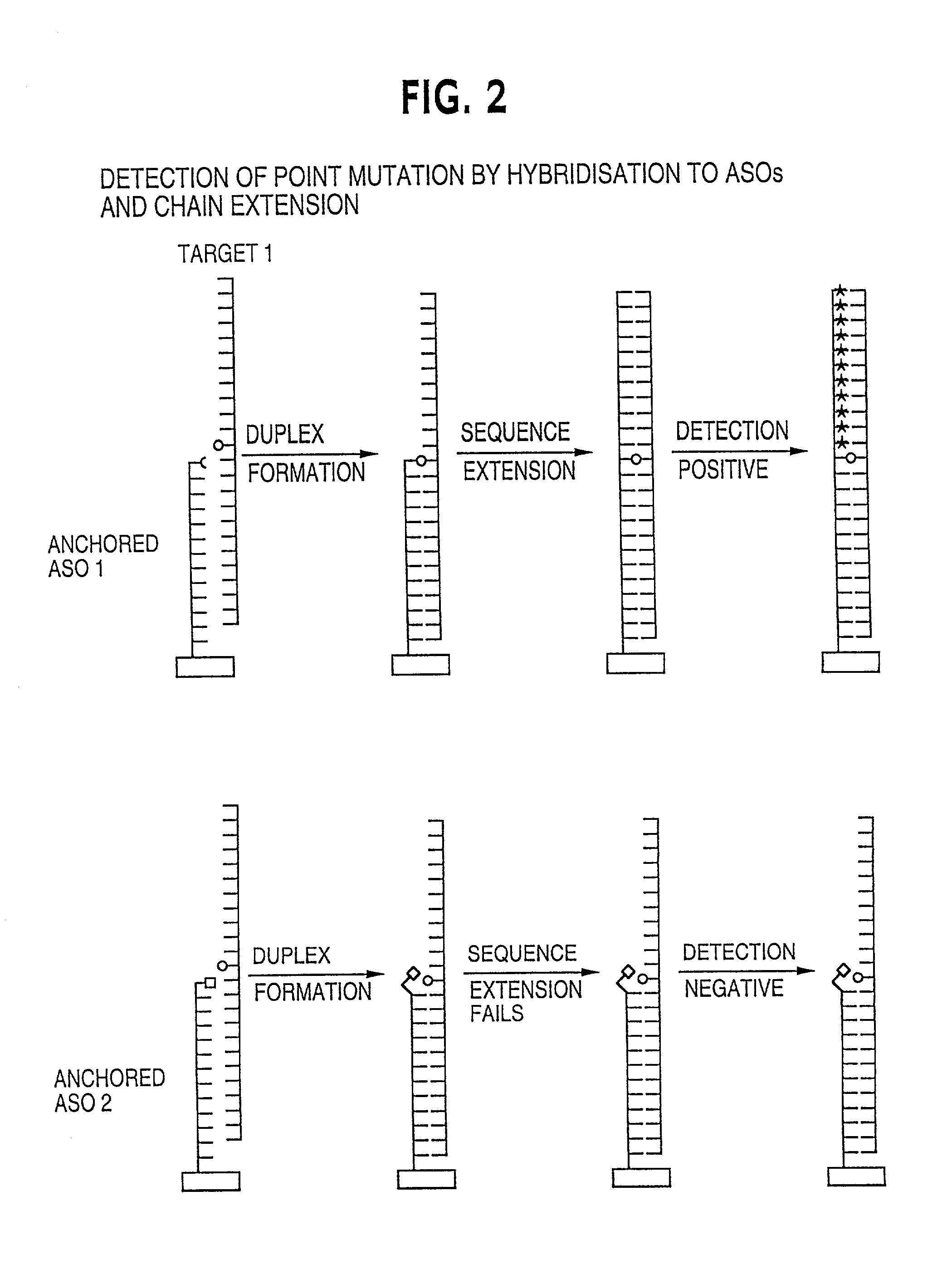Method for analysing a polynucleotide containing a variable sequence and a set or array of oligonucleotides therefor
a polynucleotide and variable sequence technology, applied in the field of methods for analysing polynucleotides, can solve the problems of difficult automation of gel electrophoresis, confusion of samples, and the inability to analyze the sequence of variables, and achieve the effect of reducing the number of samples, and reducing the number of steps
- Summary
- Abstract
- Description
- Claims
- Application Information
AI Technical Summary
Benefits of technology
Problems solved by technology
Method used
Image
Examples
example 2
[0067] Analysis of VNTR Lengths
[0068] An array of VNTR's was made as described in FIG. 4B, with the oligonucleotides anchored through their 5' ends. The repeat unit was 5' ttca and the anchoring sequence 5' cttatttccctca. Stripes 6 mm wide of sequence variants of the form: Anchor-Repeat.sub.N where N=4-8 were made on the surface of a sheet of polypropylene using "reverse" phosphoramidite monomers.
[0069] Analysis by Ligation
[0070] A strip of the array (30 mm.times.2 mm) was immersed in a solution of 600 pmols of the target oligonucleotide 5' cacagactccatgg(tgaa).sub.6t-gagggaaataag, 1.4 pmol of oligo 5' ccatggagtctgtg (labelled at its 5' end using polynucleotide kinase and .sup.33P gamma ATP) and buffer and salts according to the suppliers instructions, the total volume being 293 .mu.l. The solution was heated to 65.degree. C. and 7 .mu.l of Tth DNA ligase added. The reaction was then cooled to 37.degree. C. and left at that temperature for 18 hrs. After removal from the reaction sol...
example 3
[0071] Analysis by Ligation and Polymerisation
[0072] A strip of the array (30 mm.times.2 mm) from Example 2 was added to a solution of 200 pmols of the target oligonucleotide 5' cacagactccatgg(tgaa).sub.6tgagggaaataag, 200 pmol of oligo 5' ccatggagtctgtg (chemically phosphorylated at the 5' end) with buffer and salts according to the suppliers instructions, the total volume being 243 .mu.l. The solution was heated to 85.degree. C. and cooled to 37.degree. C. over a period of 30 mins. 7 .mu.l of Tth DNA ligase was added and the reaction mixture heated at 34.degree. C. for 17 hrs. The strip was removed and added to a solution of 8 mM DTT, 3.3 pmol .sup.32P alpha dTTP, 13 units sequenase version 2.0 and buffer and salts according to the suppliers instructions. The total volume was 250 .mu.l. After heating at 37.degree. C. for 3 hrs the strip was removed from the reaction solution, washed in TE buffer, blotted dry and exposed to a storage phosphor screen from which an image of the radio...
example 4
[0073] Analysis by Polymerisation
[0074] Two types of polymerase analysis were carried out where reporter nucleotides were chosen, in one case to identify the correct repeat length, and in the other case to identify shorter repeat lengths. This is made possible when the repeat sequence comprises less than all four bases.
[0075] In the former case a base is chosen which is present in the repeat sequence and is different from the first base in the flanking sequence. In the latter case a base is chosen to be complementary to the first base in the flanking sequence which is absent from the repeat.
[0076] A strip of the array from Example 2 (30 mm.times.2 mm) was added to a solution of 500 pmols of the target oligonucleotide 5' cacagactccatgg(tgaa).sub.6tgagggaaataag in buffer and salts at a concentration 1.09 times the suppliers instructions, the total volume being 275 .mu.l. The solution was heated to 75.degree. C. for 5 minutes and cooled to 37.degree. C. over a period of 25 mins. The so...
PUM
| Property | Measurement | Unit |
|---|---|---|
| temperature | aaaaa | aaaaa |
| temperature | aaaaa | aaaaa |
| total volume | aaaaa | aaaaa |
Abstract
Description
Claims
Application Information
 Login to View More
Login to View More - R&D
- Intellectual Property
- Life Sciences
- Materials
- Tech Scout
- Unparalleled Data Quality
- Higher Quality Content
- 60% Fewer Hallucinations
Browse by: Latest US Patents, China's latest patents, Technical Efficacy Thesaurus, Application Domain, Technology Topic, Popular Technical Reports.
© 2025 PatSnap. All rights reserved.Legal|Privacy policy|Modern Slavery Act Transparency Statement|Sitemap|About US| Contact US: help@patsnap.com



